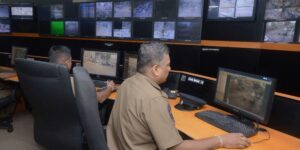Sri Lanka’s Growing Security Crisis: Assassinations, Drug Cartels, and the Fragile State of Law Enforcement
The recent assassination of notorious contract killer Ganemulla Sanjeewa, carried out by fellow assassin Samindu Dilshan Piyamanga Kahadanaarachchi, has shaken Sri Lanka’s fragile security infrastructure. While politicians assure the public of a safe environment and no national security concerns, the reality paints a far more disturbing picture—killings are rampant, drug traffickers control the streets, and the nation’s security protocols are failing.

A Kill in Broad Daylight: The Assassination That Exposed Vulnerabilities
The cold-blooded execution of Sanjeewa unfolded in broad daylight, highlighting serious gaps in Sri Lanka’s security apparatus. Samindu Dilshan, operating under numerous aliases, executed a well-planned and precisely timed attack, exploiting weaknesses in both physical security measures and intelligence gathering. While the swift capture of the assassin demonstrated effective post-incident response, the complete failure to anticipate and neutralize the threat beforehand paints a far darker picture.
This incident, which unfolded with chilling precision, is an example of how security gaps are being exploited in the country. Intelligence insiders are sounding alarms, urging that immediate action is required before these vulnerabilities spiral into something far worse.
The Power of Surprise: How Assassins Are Beating Sri Lanka’s Security

In both military and criminal operations, the element of surprise can make or break an attack. This assassination was no different. A textbook example of deception, complacency, and poor crisis response, the assassin’s strategy can teach us crucial lessons on how crime syndicates are outsmarting the nation’s security forces.
Deception Through Disguise: Blending In to Kill
The assassin and his accomplice dressed as lawyers, carrying forged IDs from the Bar Association. This clever ruse allowed them to move freely, bypassing security checks that would have been stringent for a regular citizen. This level of meticulous planning showcases the need for more rigorous security vetting and screening processes.
Routine and Complacency: The Dangerous Comfort of Predictability
Security personnel in high-risk areas, such as courts, often fall into the trap of complacency due to predictable routines. The assassin likely spent several days studying the location, becoming familiar with the building’s entrances and exits, and the security officers’ patterns. This allowed him to plan the attack without raising any suspicion.
Weapon Concealment: Smuggling Death in Plain Sight

Perhaps one of the most cunning aspects of the assassination was the concealment of the weapon. The firearm was hidden inside a statute book, carried by the female accomplice. This tactic took advantage of the assumption that legal professionals would not be armed, and books were not subjected to thorough security screenings.
Security Failure: A Breakdown in Risk Management
The assassination has brought to light significant security weaknesses, particularly in threat anticipation and risk management. Here are some critical failures:
Lack of Intelligence and Proactive Screening
Given the victim’s high-risk profile, there should have been proactive intelligence gathering on potential threats. The assassin’s suspicious movements in the days leading up to the attack went undetected, and there were no red flags raised.
Failure in Access Control
A forged Bar Association ID should never have been enough to bypass security. The lack of thorough identity checks raises questions about the effectiveness of the nation’s access control measures.
Reactive Security, Not Proactive Security
Security personnel were woefully unprepared for an armed assault. No protocols were in place for an active shooter situation, and the response was delayed, with officers freezing in the face of the threat.
Lessons and Urgent Steps Forward

This event serves as a wake-up call for Sri Lanka’s security forces and law enforcement agencies. There are key lessons to be learned and urgent changes to be made:
Adopt Intelligence-Driven Security Protocols
To anticipate threats, Sri Lanka must enhance surveillance systems, improve intelligence coordination, and implement real-time threat detection.
Strengthen Access Control and Screening
Randomized security checks, biometric ID verification, and better access control protocols can help prevent disguised attackers from slipping through the cracks.
Revamp Crisis Response Training
Sri Lanka’s security personnel need better training to handle active shooter situations, ensuring they react swiftly and decisively in high-stress scenarios.
Deploy Advanced Technology
AI-driven surveillance systems and real-time coordination between security and intelligence agencies will help identify potential threats before they escalate.
Turning a Crisis Into an Opportunity for Reform
The swift arrest of the assassin is commendable, but it is far from enough. Sri Lanka’s security landscape is failing, and urgent reforms are needed to ensure this assassination is not just another incident lost in a long line of security failures.
By embracing proactive risk management, improving intelligence sharing, and modernizing security protocols, Sri Lanka can prevent future incidents and ensure its citizens are genuinely safe. It’s time to eliminate complacency and predictability, because when it comes to national security, the best defense is one that never allows the element of surprise to prevail.







